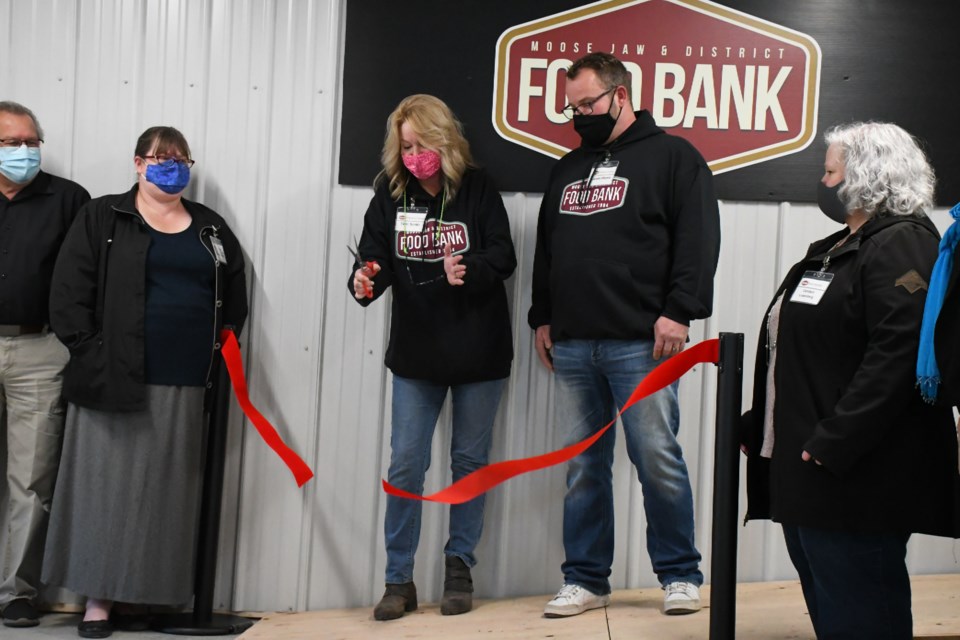The Moose Jaw & District Food Bank had a difficult year in 2021, including a move to a new building, but a surge of support carried them through.
The food bank had to cope with a rapid increase in need starting around September 2021.
Terri Smith, operations director, said that when COVID-19 hit in 2020, they saw a surprising drop in numbers. She attributed this drop to people being afraid to leave their homes for fear of the disease.
Since then, the number of people relying on the food bank has steadily increased — and it has now surpassed pre-COVID-19 numbers.
Smith said that 2019 was a rough year for many people, as 10,960 came to the food bank for help, and the average number of hampers given out in 2019 was 402.83. Those numbers are quite high, but 2020 was lower. Many clients reported that CERB and the subsequent CRB kept them fed in 2020. The drop came in April as the first flurry of COVID adaptations began. The following numbers are food hampers distributed by month for 2020:
- January: 432
- February: 376
- March: 384
- April: 118
- May: 135
- June: 141
- July: 174
- August: 192
- September: 240
- October: 286
- November: 275
- December: 314
The average for 2020 was 255.58, a drop over the 2019 average of about 150 food hampers. The total of people served was 7,088. Nevertheless, the climb back up is evident as the year progresses. Here are the numbers for 2021:
- January: 280
- February: 279
- March: 324
- April: 297
- May: 270
- June: 304
- July: 234
- August: 362
- September: 315
- October: 447
- November: 583
- December: 555
The average month in 2021 saw 354.17 hampers distributed, and a total of 8,707 people served.
However, notably, the last three months of 2021 were significantly higher than in 2019:
- October 2019: 396
- November 2019: 414
- December 2019: 449
Smith said that the CRB ending in October 2021 is probably what caused that jump. She also said that the ongoing issue of the new Saskatchewan Income Support (SIS) program cutting direct payments to landlords likely had an influence.
Clients on SIS are much less likely, for a variety of reasons, to have the financial skills to effectively manage their money. According to many critics, giving such clients their rent money directly has caused homelessness in the province to increase. Smith said the food bank has seen that happening.
As of Jan. 30, they have distributed 610 hampers. Despite the higher overall amount of people served in 2019, the highest month that year was August, with 451 hampers distributed.
As the need increased in the final months of last year, Smith said, Moose Javians stepped up to make sure no one went hungry. “I give Moose Jaw a lot of credit. A lot of our agencies, the churches, the schools, a lot of the social workers were going above and beyond.”
The Moose Jaw & District Food Bank saw disruption last year with their move to a new building. Maintaining their food distribution during COVID restrictions and while managing the move was challenging. Now that they’re in a larger building, with a lobby that can accommodate social distancing, they don’t anticipate further problems.
They are planning on opening a drive-thru eventually, which will help even more people – especially those nervous about COVID – to come for the food they need.
Smith said things have gotten bad. She’s been with the food bank for nearly 20 years, and she’s seen many clients she’s known for a long time crushed by the emotional, social, and economic pressures of the last few years.
The way the community has come together helps to provide a positive perspective. The community has always been a giving one, Smith said, but “I’ve never seen so many people want to step up and volunteer or give their time or just, I mean, they give whatever they have. It’s a great place, I’m really proud of Moose Jaw.”




